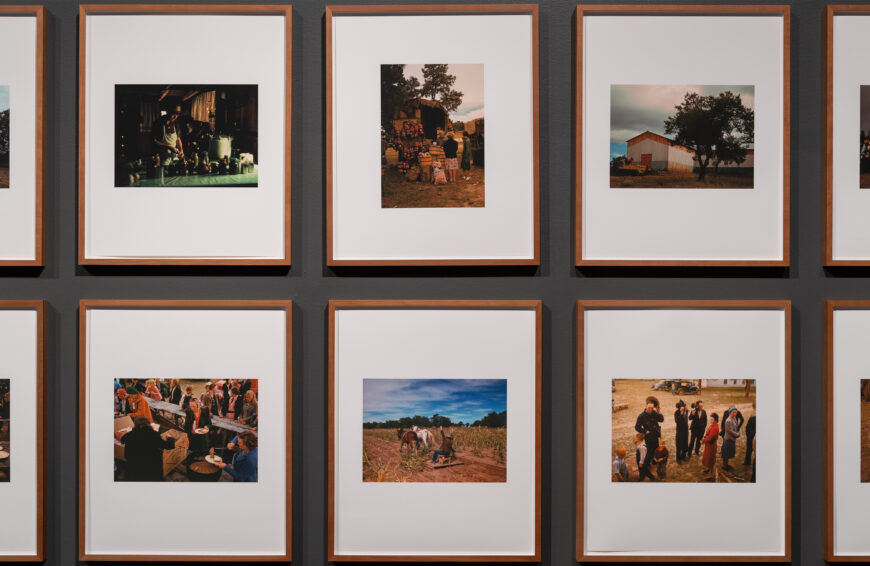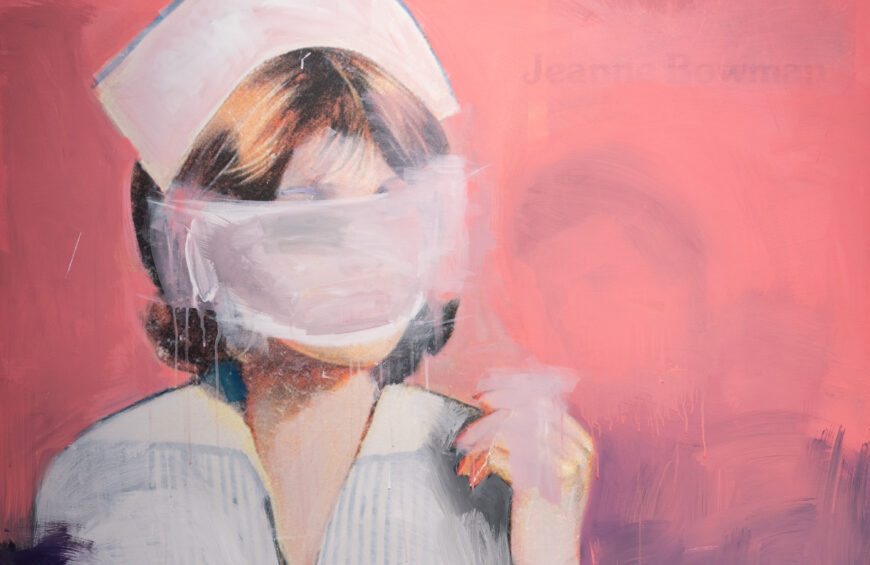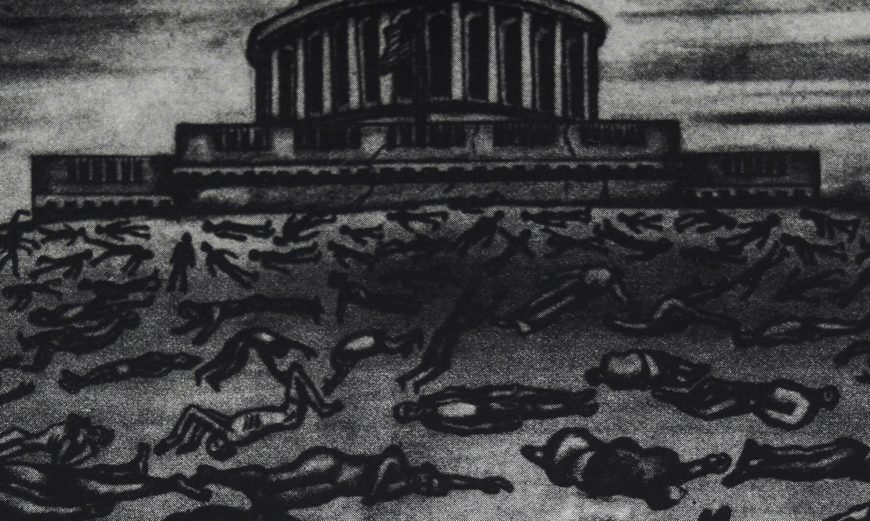
Sue Williamson, Albertina Sisulu, 1984, photo etching/screen print, collage, 70 x 64 cm © Sue Williamson
A woman sits, casually, as if posing for a family portrait. Dressed in her nice, Sunday clothes, she appears to be relaxed and with a slight smile on her face. She seems unaware of the highly-charged political images that surround her. This woman, whose name is Albertina Sisulu, was a courageous activist in South Africa’s anti-apartheid movement, and these images help to tell us the story of her life. South African artist Sue Williamson depicted Albertina Sisulu in portrait form as part of a series focused on women anti-apartheid activists.
Albertina Sisulu dedicated her life to liberating South Africa from apartheid rule. As one of the most prominent female anti-apartheid activists, Sisulu was a member of the ANC Women’s League, and she helped to set up the Federation of South African Women, two of the most significant and influential women’s organizations in the resistance movement.
This work is one of 17 portraits in A Few South Africans, a series of works made from 1983–87 that feature women who participated in South Africa’s liberation movement. The series is notable because it is the first artistic effort to place women’s political contributions within the wider political environment of South Africa’s struggle against apartheid.
In this depiction, Williamson centers a photographic portrait of Sisulu, seated from the knees up, who wears a head wrap, floral-patterned skirt, and a white cardigan that is loosely open at the neck. She sits comfortably; her hands rest casually on her lap, fingers together, and her head is tilted slightly to the right. Her gaze is at, or perhaps beyond, the viewer.
A portrait of a political activist
Williamson positions Sisulu within a landscape that helps to tell the biographical story of this impressive woman. To the left, we see a township scene, which indicates the kind of community where Albertina Sisulu once lived. It also speaks to how her political leadership was inclusive of family and community (Albertina gave birth to five children and, together with her husband Walter Sisulu, also a political activist, raised three more).
To the lower right, we can see an archival photograph of a United Democratic Front (UDF) meeting. The UDF was a multi-racial anti-apartheid political body that brought together many anti-apartheid organizations, including churches, civic associations, and trade unions. In the adjacent purple border, the artist also includes an activist marching while waving a UDF banner. Albertina Sisulu helped establish the UDF and served as one of its three co-presidents.
Sisulu’s portrait is surrounded by a decorative border which references how important family photographs were displayed with colorful paper frames in the domestic spaces of South Africa’s townships. The prominence and design of the border are influenced by visual culture practices that were specific to Crossroads, a squatter camp located on the outskirts of Cape Town where Williamson spent time as a political activist. During her work in Crossroads, Williamson admired the ways in which individuals adorned their own family photographs with home-made, decorative borders crafted from fragments of colorful gift wrap and wallpaper. This practice, in turn, became a visual inspiration for Williamson’s own work seen here with the colorful purple, patterned border surrounding the primary image.
Colorful patterns commonly found on African textiles which were readily available in street markets also influenced the color and patterns on the borders of this series, which are then overlaid with smaller archival images that help to tell the story of the subject’s life. To the left are five figures representing the security police who terrorized Albertina and her family members (she was detained on a number of occasions, including being placed in solitary confinement in 1963. Then in 1964, she was banned from participating in public life for ten years). And on the right is another reference to the UDF, shown through the figure of a single activist, marching and holding a UDF banner. This underscores the organization’s importance as a liberation movement and in Sisulu’s life.

Sue Williamson, Virginia Mngoma, 1984, photo etching/screen print, collage, 100 x 70 cm (Tate) © Sue Williamson
The series
A Few South Africans was Sue Williamson’s first substantial body of work, and it helped to create and sustain political identities and recognition for women, including Williamson herself. Sue Williamson is an artist whose life’s work is deeply integrated into South Africa’s political history: she was a central figure in the resistance arts movement during the fight against apartheid, and she continues to confront South Africa’s most pressing political and social issues in the current era. As an artist, Williamson was, and remains, highly respected for her involvement in human rights organizations associated with the anti-apartheid movement, and for her efforts to make visible the experiences of people and communities who were marginalized under apartheid’s oppressive rule.
In this series, Williamson sought out women who deserved recognition for their contributions to the struggle against apartheid, yet who were not necessarily perceived as “heroic.” In addition to the works discussed here, A Few South Africans includes biographical portraits of other important figures (including Lilian Ngoyi, Amina Cachalia, Mamphela Ramplele, Jenny Curtis Schoon, Winnie Mandela, Elizabeth Paul, Maggie Magaba, Annie Silinga, Nokukanye Lutuli, Helen Joseph, Caroline Motsoaledi, Charlotte Maxeke, and Amina Cachalia). Williamson either photographed each of the subjects herself, or sourced their images from library archives (including banned books), such as the ones we see in the border of this portrait. Similar to the portrait of Sisulu, in other works in the series place the subject centrally within a colorful frame in a manner that makes them recognizable and identifiable to a viewer, and for the historical record. This is important, and also unusual: very few individual women in South Africa’s liberation struggle have been depicted in the visual arts despite their deep and widespread engagement and impact. Even today, when they are referenced, they tend to be depicted either in nonrepresentational terms, or else they are shown in relation to men.

Sue Williamson, Case No. 6831/21, 1984, photo etching/screen print, collage, 100 x 70 cm (Tate) © Sue Williamson
Each work in A Few South Africans tells a story about the subject’s particular contribution to the struggle against apartheid, making reference to both biographical and political content. Case No. 6831/21 is the only work in the series that does not depict a recognizable woman, but instead bears witness to countless anonymous women who were not permitted by law to live with their husbands in urban areas (where their husbands worked). This particular image honors those women and is inspired by Williamson’s political work in Crossroads, which had a deep personal impact on her and intensified her commitment to depicting lives of individuals and communities displaced and destroyed by apartheid’s practices. The woman at the center represents thousands of Xhosa women who traveled long distances with their children from their homelands in the Transkei (represented through the distinctive domestic architecture depicted in the work’s frame) to the squatter camps surrounding Cape Town (shown in the background, behind the central figure) in an effort to follow their migrant-laborer husbands. These women were terrorized and assaulted by the police, and were arrested on a regular basis and charged with living illegally in the area. Williamson aims to bring humanity, dignity, and visibility to their lives and struggles by depicting one such woman here.
Images for a broad audience
A Few South Africans showcases the artist’s technical mastery in printmaking. The choice printmaking is also political. Prints allow for multiple editions that can be displayed in various places, to a wide audience. As part of her political work, Williamson also reproduced A Few South Africans in the form of postcards and posters which were circulated widely—throughout South Africa and beyond—allowing the images to be seen by a wide general public.
Today, the postcards and prints are in museum collections around the world, including The Museum of Modern Art (New York), the V&A Museum (London), the Newark Museum (New Jersey), Wheaton College (Massachusetts), and the Walther Collection in Germany. And in 1994, following South Africa’s first democratic elections, A Few South Africans was among the first works of art to be prominently displayed in South Africa’s Parliament Buildings.
Through these works, Sue Williamson documents the leadership and courage of individual women and ensures that women’s political work becomes part of both South Africa’s visual and historical record. With this image, Albertina Sisulu’s steady, courageous, collaborative political work will always be remembered.






